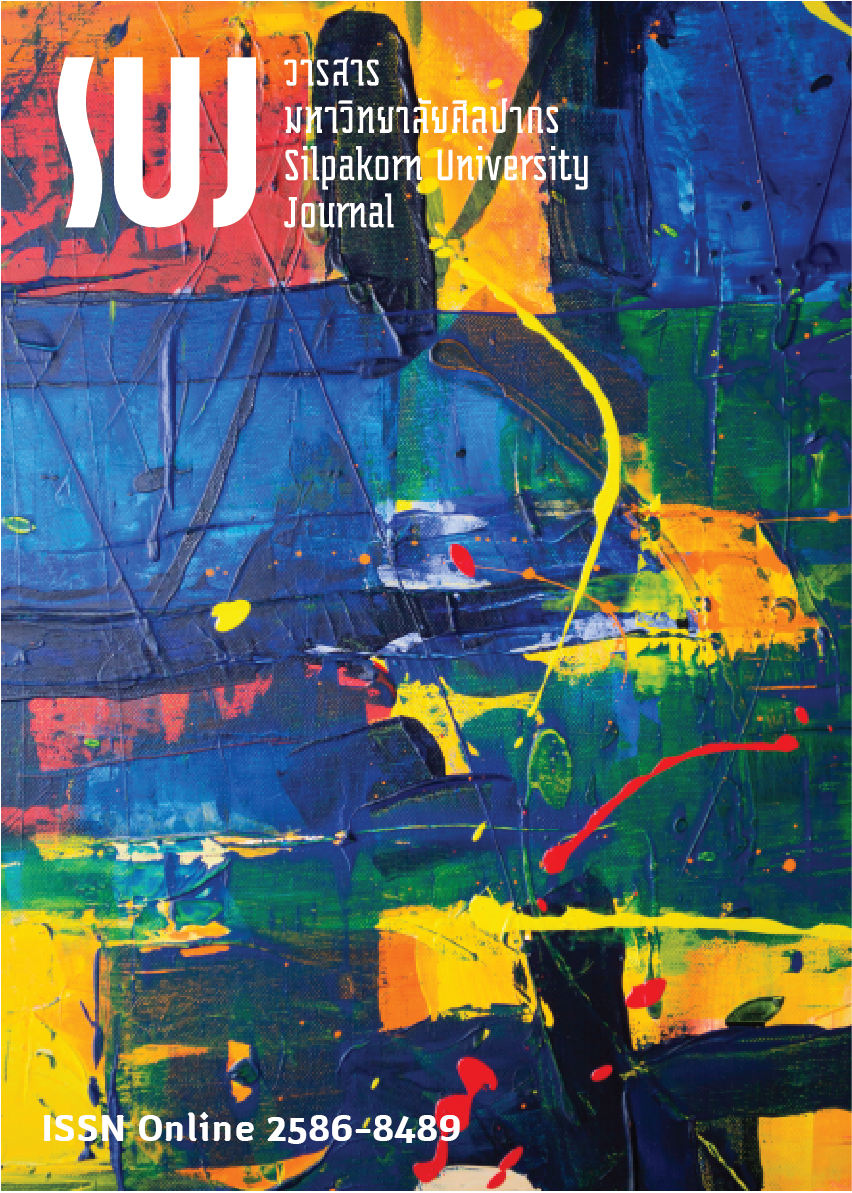“เสียง” ที่เปลี่ยนไปของนักศิลปะบำบัดในงานวิจัยเรื่องเล่า: กรณีศึกษา (The changed “voices” of an art therapist in narrative inquiry: a case study)
Main Article Content
Abstract
บทความนี้มีวัตถุประสงค์เพื่อนำเสนอประเด็นที่สำคัญของงานวิจัยเรื่องเล่า ด้วยการวิเคราะห์ “เสียง” ที่เปลี่ยนแปลงไปของนักศิลปะบำบัดในการจัดกระบวนการศิลปะบำบัดแก่ผู้เข้าร่วมซึ่งเคยประกอบอาชีพ ขายบริการคนหนึ่ง โดยผู้วิจัยเป็นนักศิลปะบำบัดในงานวิจัยของตนเอง “เสียง” ในที่นี้ หมายถึงเนื้อหา วิธีการและจุดยืนในการเล่าเรื่อง ผู้วิจัยพบว่า “เสียง” ของตนเองในช่วงแรก ๆ เป็นเสียงจากมุมมองของคนนอก เนื้อหาส่วนใหญ่ประกอบด้วย ข้อเท็จจริง ข้อมูลที่ได้รับฟังจากผู้เข้าร่วม มีเสียงวิพากษ์วิจารณ์บ้าง ต่อมาเป็นเสียงแห่งความรู้สึกขัดแย้งในใจของตนเอง โดยเฉพาะเมื่อได้รับฟังผู้เข้าร่วมกระบวนการศิลปะบำบัดเล่าเรื่องประสบการณ์ทางเพศอย่างเปิดเผย นักศิลปะบำบัดสามารถเข้าใจตนเองมากขึ้นผ่านการกลับมาทบทวนตนเองและย้อนทวนประสบการณ์ในอดีต และเห็น “กรอบ” ที่ตนเองใช้เป็นมาตรฐานในการตัดสินคน เช่น มาตรฐานทางจริยธรรม การเข้าใจโลกทัศน์และยอมรับความรู้สึกของตนเอง ทำให้จุดยืนของนักศิลปะบำบัดเคลื่อนใกล้เข้า ผู้เข้าร่วมมากขึ้นจนถึงจุดหนึ่งที่รู้สึกเข้าใจและเชื่อมโยงกับผู้เข้าร่วมอย่างที่เขาเป็น เกิดความเข้าใจในความรู้สึก เป็นมุมมองใหม่และความหมายใหม่ในความสัมพันธ์ระหว่างมนุษย์ ซึ่งเป็นประเด็นที่สำคัญในงานวิจัยเรื่องเล่า
The main objective of this study is to analyze the “voices” of myself as an art therapist. I have conducted a research of my own voices in art therapy sessions with a participant who was a sex worker. “Voices” here include contents, methods, and standpoints of the narrator. I, as a researcher, have found that at the beginning, my “voices” seemed distant, and the narrated contents were facts, information from the participant, and a few criticisms. The following voice was full of conflicts, especially when the participant talked about her sexual experiences explicitly. Self-reflection and re-experiencing the past experiences helped me, as an art therapist, to gain more understanding of the “frame of references” in judging people, one of which was my ethical standards. My standpoint as an art therapist moved closer to the participant as I understood more of my own worldviews and accepted more of my own feelings. I reached the point of human connection when I truly understood and accepted the participant as she really was, which was the fruit of self-understanding. It then became the new perspective and new meaning in human relations, which were a crucial point of narrative inquiry.
Downloads
Article Details

This work is licensed under a Creative Commons Attribution-NonCommercial-NoDerivatives 4.0 International License.
References
Chase, S. E. (2005). Narrative Inquiry: Multiple Lens, Approaches, Voices. In The Sage Handbook of Qualitative Research, edited by Norman K. Denzin & Yvonna S. Lincoln (3rd ed.). Thousand Oaks, California: Sage Publications.
Dailute, C. (2014). Narrative Inquiry: A Dynamic Approach. London: Sage Publications.
Elliot, J. (2005). Using Narrative in Social research: Qualitative and Quantitative Approach. London: Sage Publications.
Kim, J. H. (2016). Understanding Narrative Inquiry: The Crafting and Analysis of Stories as Research. London: Sage Publications.
Malchiodi, C. A. (1998). The Art Therapy Sourcebook. Los Angeles: Lowell House.
Pinnegar, S., & Daynes, J. G. (2007). Locating Narrative Inquiry Historically. In Handbook of Narrative Inquiry: Mapping A Methodology, edited by D. Jean Clandinin. Thousand Oaks, California: Sage Publications.
Rubin, J. (2001). Discovery, Insight, and Art Therapy. In Approaches to Art Therapy: Theory and Practices, edited by Judith Aron Rubin (2nd ed.). New York: Brunner-Routledge.
Ruktaengam, Himapan. (2018). Contemplative Education in Narrative Inquiry. In the 9th Conference on Holistic Learning for Thriving to be Wholesome. Bangkok: Asorm Silp Institute and Contemplative Education Center, Mahidol University.
Ruktaengam, Himapan. (2018). Self and (Those Who are Made) Others: A Narrative from A Narrative of An Art Therapist (ตัวตนและคน (ที่ถูกทำให้เป็น) อื่น: เรื่องเล่าจากเรื่องเล่าภาคสนามของนักศิลปะบำบัด). [Unpublished Manuscript]. Nakhon Pathom: Mahidol University.
Ruktaengam, Himapan., & Daensilp, Proetphan. (2019). Mindfulness-Based Art Therapy: from the perspective of Art Therapists (การบำบัดด้วยศิลปะโดยใช้สติ: จากมุมมองของนักศิลปะบำบัด). In the 10th Conference on Transformative Learning. Bangkok: Asorm Silp Institute and Faculty of Learning Sciences and Education, Thammasart University.


